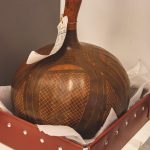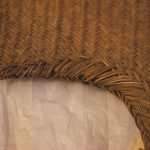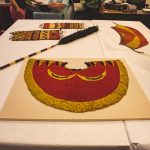Today, July 20, was a heavy day. We traveled very far to the outskirts of downtown London to one of many of the British Museum’s store houses. We learned today that the British Museum, one of the largest museums in the world, has 7 million items in its collection. But because they only display about 1% of the total items in its collection in its public museums, there are many store houses spread across the city to store the other 99% of its items that either just sit or await its turn in the circuit to be put on display or loaned to another museum. Of the 7 million British Museum items, 900 are categorized as originating from Hawaiʻi.
The particular “store” (as it is called) we visited today to meet Dr. Julie Adams (curator for the Oceania Collections in the Department of Africa, Oceania and the Americas for the British Museum) was located in Haggerston. After traveling by bus, then tube and then overground train, we got off in Haggerston feeling like we were lost. It was an on-the-cusp-of-gentrification little town, semi-industrial and random. Even the instructions to get there suggested that this store house was purposefully placed in an area as to not draw attention to the values contained within. A very discreet “B.M. Store” sign was the only evidence that we had stumbled on the right place.
Dr. Adams was very sweet and accommodating. After a quick check-in and distribution of visitor badges, we were escorted to a large ground-floor room where we were immediately rushed into a large warehouse-like room packed with dominating pieces from around the world. Toward the end of the room we all quickly saw what we were being sent to see: a kiʻi Kū brought out ahead of the other images and items in the room. It is difficult to describe the array of feelings and emotions we all had, but it prompted lots of conversation after. Our group asked for a room to ourselves to deliberate, reflect, and process–and that we did. After quite some time processing and taking moments to pause, we continued with the visit Dr. Adams prepared for us, including seeing an array of other items in their “possession,” such as a few ʻ ahu ʻula, mahiole, fans, a drum, and other items from Hawaiʻi. Our visit today made ultra visible our class discussion a few days ago about museums and colonial extraction, something that was apparent after our visit to the Louvre. Today, though, our discomfort about museums and their philosophy, approach and protocol was taken to another level.
We talked about how a trip to a museum is seen as such a benign thing to do when you visit a city. Now, we cannot help but think differently: about museums being so inherently violent, not benign but actively exploitive. So little is known about what it took to “acquire” these items, both the physical extraction, and the metaphorical one. Colonization and empire plays such a large role in the extraction of people’s physical items, but also our spirit. And to what end? For “everyday” people from around the world to play cultural tourist, transporting themselves to different parts of the world through their simple walking from one room to the next? And what about our “items”–our ancestors, our gods, the items of our aliʻi–sitting in boxes in storage, or on display for the consumption of others. How much longer will this be acceptable?
Photo Credits: Anianikū Chong




















